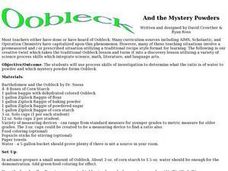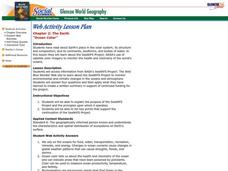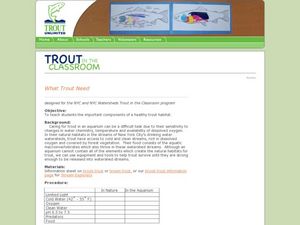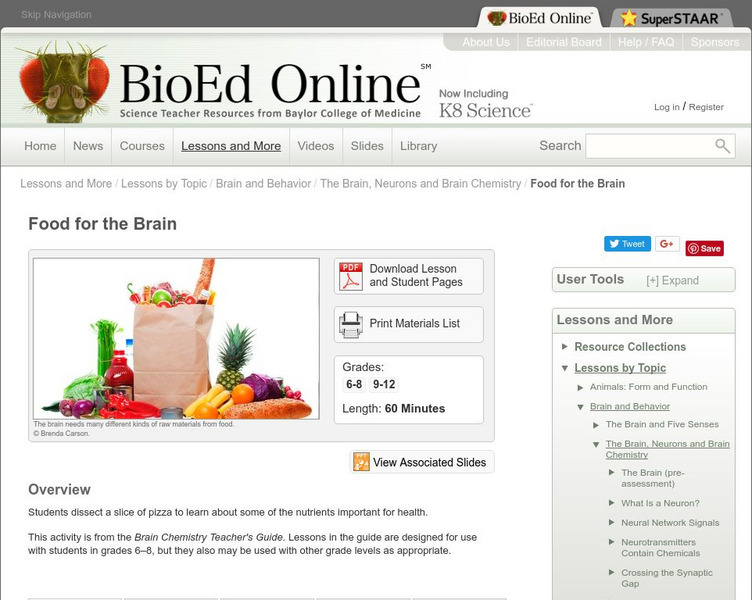Curated OER
Carbon: Structure Matters
Students read the Who We Are Section on Calfee Designs Webpage and discuss carbon usage. They work in pairs to look up the minerals diamond and graphite then create a chart on the properties of each mineral then compare how they differ...
Curated OER
Now Take a Deep Breath
Learners research to answer questions related to deep sea diving. In this deep sea diving lesson, students answer questions on a worksheet using the Internet. They discuss pressure, gas laws, and the physiology of diving in the deep sea.
Curated OER
Oobleck and the Mystery Powders
Students listen to the book, "Oobleck," by Dr. Suess before experimenting with mystery powders. They determine the proper ratio of powder to liquid to make the Oobleck.
Curated OER
Earth Water Distribution and Water Consumption
Students explore the need for conserving fresh water and understand that it is a limited supply. In this water consumption lesson students participate in an activity and answer questions.
Curated OER
The Electric Sieve
Students examine different mixtures and how they can be separated. In this electric sieve lesson students complete an activity that allows them to separate mixtures.
Curated OER
Little Me in a Big World: Ants
First graders predict, observe and record strategies to overcome them using discussions, role play, and charts. Over a three or four day period, they examine obstacles that humans and insects encounter.
Curated OER
Microarrays: Chipping Away at the Mysteries of Science and Medicine
High schoolers research microarrays on the internet in cooperative groups. Students write an essay describing the use of microarrays in environmental research and in medicine.
Curated OER
Raindrops Keep Burning On My head
Students investigate the effects and causes of acid rain. They test pH of household items to familiarize themselves with pH scale and compare that information with acid rain solutions. They investigate impact of acid rain via internet...
Curated OER
The Exceptional Nature of Cellulose
Students observe the affects of a substance's composition and structure have on its solubility. In this cellulose lesson plan students compare the amount of energy required to dissolve mono-saccharides with that required to dissolve...
Curated OER
Radius, Diameter and Area
Students identify the radius and diameter of a circle. In this geometry lesson, students calculate the volume and area of a cylinder and circle. They relate the circumference of a circle to Pi.
Curated OER
Unit Circle and Triangle
Students apply the Unit Circle to solve ratios of triangles. In this geometry lesson, students derive the different ratios of a triangle using the Pythagorean Theorem. They find the angles of a unit circle using a right triangle.
Curated OER
Are Polymers Photodegradable?
Learners study the term photodegradability and how it applies to the 6-pack loop ring. In this materials lesson plan students test photodegradability of the 6-pack plastic ring.
Curated OER
Spectrophotometry Lab
Students use a machine called a spectrophotometer to determine how much light is absorbed by certain substances. Students record the absorbance and the % of light transmitted for different color solutions, graph their results, and then...
Curated OER
Ocean Color
Students examine NASA's SeaWiFS Project Web site to explore how the SeaWiFS Project monitors environmental and climatic changes in the oceans and atmosphere. They answer questions and write a summary in support of continued funding for...
Curated OER
Mini-Volcanoes!
Students define volcanoes and why they erupt. Using baking soda, vinegar, and soap detergent, students create and observe their own volcanoes erupting. A brain-pop video can be used to follow-up the activity (found on website).
Curated OER
Is it Alive?
Students watch a demonstration using Duco glue and water and try to determine if the "monster" shown is alive. After the demonstration, they discuss what characteristics make an organism "alive". They participate in a card sorting...
Curated OER
It Looks Like Champagne
Students determine some practical implications of the discovery of liquid carbon dioxide in deep-ocean ecosystems. They interpret phase diagrams and explain the meaning of "critical point" and "triple point."
Curated OER
Pigment Plucking
Students examine pigments found in different fruits and vegetables and practice the processes for extracting the pigments. Pigments are used to create artwork and a class PowerPoint presentation is made on the different types of plant...
Curated OER
Frozen Water Before? I'm Sure You Have; But I Bed You've Never Frozen Salt Water! Water!!
Students examine what happens to salt water when it freezes. In groups, they measure density and salt concentrations in different samples of water and record its freezing time. They discuss the relationship between water density and...
Curated OER
What Trout Need
Students investigate the important components for a healthy trout habitat. In this fish habitat lesson, students discuss how the aquarium will simulate a trout's environment in nature. Students complete a trout information sheet to set...
Curated OER
Photosynthesis and Respiration
Eighth graders differentiate photosynthesis and respiration. In this biology instructional activity, 8th graders draw a diagram explaining these two processes. They answer a quiz after the instructional activity.
BioEd Online
Bio Ed Online: Food for the Brain
The brain needs many different kinds of raw materials from food and ecommended serving sizes are often smaller than the size actually served or the amounts people eat. In this lesson learners are introduced to this concept by dissecting...
PBS
Pbs Learning Media: The Ruff Ruffman Show: Teacher's Guide: Kitchen Chemistry
Learn about kitchen chemistry alongside Ruff Ruffman. Learners can use the videos, games, and activities from The Ruff Ruffman Show to discover how by investigating solids and liquids and exploring heating and cooling, science can help...
Royal Society of Chemistry
Royal Society of Chemistry: Kitchen Chemistry: Is All Salt the Same? [Pdf]
Lesson plan investigation into types of salts used to season foods and in recipes asks students to consider and whether advertisers' claims about their salt products are truthful.
Other popular searches
- 4th Grade Food Chemistry
- Food Chemistry Pdf
- Food Chemistry Quiz
- Food Chemistry Pancakes
- Food Chemistry Protein
- Food Chemistry Detection
- Food Chemistry Mcq
- Food Chemistry Pd
- Food Chemistry Cakes
- Food Chemistry Protien
- Food Chemistry Mc
- Food Chemistry Pancackes
























